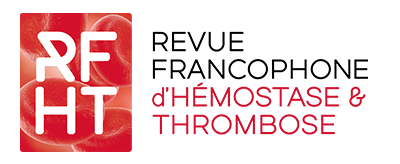RÉSUMÉ
L’utilisation des anticoagulants oraux directs (AOD) est de plus en plus répandue, y compris chez les patients atteints de cirrhose. Ces traitements perturbent les examens d’hémostase, modifiant les scores MELD et de
Child-Pugh, essentiels pour évaluer la gravité de la maladie et hiérarchiser les patients sur liste d’attente de
transplantation hépatique. Nous avons examiné l’impact de la supplémentation in vitro en rivaroxaban (300 ng/mL) et en apixaban (150 ng/mL) sur ces scores. Trente-cinq échantillons de plasmas de patients atteints de cirrhose (TP : 13-104 %) ont été analysés. L’INR (International Normalized Ratio) et le TP (temps de prothrombine) ont été mesurés avant et après supplémentation, puis après neutralisation des AOD par du charbon (DOAC-StopTM). La supplémentation en AOD a entraîné une augmentation médiane de l’INR (rivaroxaban : x2,78 ; apixaban : x1,45), entraînant une surestimation médiane du score MELD de 11,5 et 4 points respectivement. Le TP a été sous-estimé (rivaroxaban : -70 % ; apixaban : -48 %), affectant le score de Child-Pugh pour certains patients. La neutralisation des AOD par le charbon a permis de restaurer des valeurs d’INR et de TP comparables à celles mesurées avant supplémentation. Ces résultats montrent l’importance d’identifier les patients sous AOD et d’utiliser des techniques de neutralisation pour éviter une surestimation de la gravité de la maladie, susceptible de mener à des erreurs dans la gestion clinique et la priorisation sur liste de transplantation hépatique.
MOTS CLÉS
anticoagulant oral direct, charbon, Child-Pugh, cirrhose, MELD
ABSTRACT
The use of Direct Oral Anticoagulants (DOACs) is increasingly common, including among patients with cirrhosis. These treatments interfere with coagulation tests, altering the MELD and Child-Pugh scores, which are critical for assessing disease severity and prioritizing patients on liver transplant waiting lists. We investigated the in vitro impact of rivaroxaban (300 ng/mL) and apixaban (150 ng/mL) supplementation on these scores. A total of 35 plasma samples from patients with cirrhosis (PT: 13-104%) were analyzed. INR (International Normalized Ratio) and PT (Prothrombin Time) were measured before supplementation, after supplementation with DOACs, and after DOAC neutralization using activated charcoal (DOAC-StopTM). DOAC supplementation resulted in a median INR increase (rivaroxaban: x2.78; apixaban: x1.45), leading to a median MELD score overestimation of 11.5 and 4 points, respectively. PT was underestimated (rivaroxaban: -70%; apixaban: -48%), affecting the Child-Pugh score in some patients. Neutralization of DOACs with activated charcoal restored INR and PT values to levels comparable to those measured before supplementation. These findings highlight the importance of identifying patients on DOAC therapy and implementing neutralization techniques to avoid over estimating disease severity. Failure to account for DOAC interference could lead to mismanagement and errors in prioritizing patients for liver transplantation.
KEYWORDS
charcoal, Child-Pugh, cirrhosis, direct oral anticoagulant, MELD

